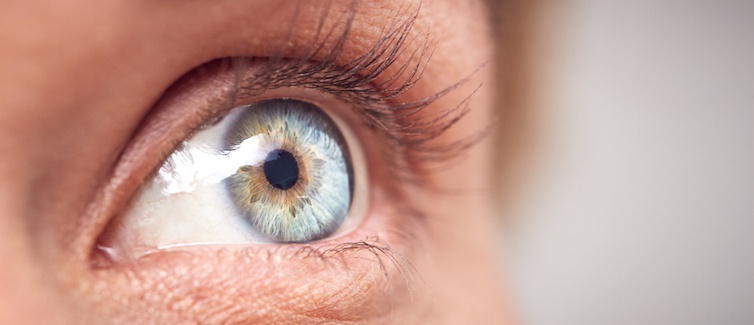Your corneas are your windows to the world. They’re the clear domes that form the front of your eyes.
As light enters your eye, the curved edge of the cornea bends the light rays. This helps with visual focus. The cornea also acts as a protective barrier against germs and dirt.
In short, your corneas play a key role in your vision and eye health. That’s why serious corneal damage and advanced corneal disease may lead to vision loss. But medicines, customized laser treatments, and corneal transplants are available. And new stem cell therapies are being researched.
Common Cornea Conditions
Several common conditions can affect the cornea. They include eye infections, corneal abrasions (scratches on the surface of the eye), and dry eye. Symptoms may include:
- Eye discomfort
- Red or watery eyes
- Blurry vision
- Light sensitivity
Most of these conditions are readily treatable. But sustaining a deep scratch to the cornea — or waiting too long to seek treatment for an infection — may lead to permanent vision loss.
Never Miss a Beat!
Subscribe to Our HealthBeat Newsletter!
Thank you for subscribing!
You can now select the specific newsletters you'd like to receive.
You are already subscribed.
Subscribe to more newsletters in our email preference center.
Sorry, an error occurred. Please try again later.
Get Healthy Tips Sent to Your Phone!
Genetic Corneal Dystrophies
Corneal dystrophies are less common but potentially serious cornea diseases that generally run in families. These diseases cause changes inside the cornea. Over time, the cornea may lose its transparency, leading to cloudy or blurry vision. There are several types of corneal dystrophies, including keratoconus and Fuchs’ dystrophy.
Keratoconus affects about 1 in 2,000 people in the United States. This disease causes the normally rounded cornea to get thinner and bulge outward in a cone shape. It’s typically diagnosed during the teen or young adult years. Continued changes in contact lens or eyeglass prescriptions, blurred or distorted vision, and problems with night vision can be early signs of keratoconus in a young adult.
Fuchs’ dystrophy causes the cells that normally pump fluid out of the cornea to stop working. Fluid builds up and the cornea becomes swollen. Symptoms usually start to appear around the ages of 50 to 60.
Treating Corneal Problems
Many corneal conditions can be treated effectively with corrective lenses, over-the-counter eye drops, or prescription medicines. Some people need other treatment options, such as phototherapeutic keratectomy (PTK). PTK uses advanced laser technology to reshape the cornea, remove scar tissue, and restore clear vision. This may necessary if:
- A corneal injury or infection has caused permanent scarring that seriously impairs vision
- Corneal dystrophy has progressed to the point of significant vision loss
Corneal Transplant Surgery
If your cornea can’t be repaired with other treatment options, corneal transplant surgery is another possibility. The surgeon removes the affected part of the cornea and replaces it with healthy corneal tissue from a donor. According to the Eye Bank Association of America, more than 97% of corneal transplants successfully restore vision.
Corneal transplant surgery is usually done on an outpatient basis, so you can go home the same day. It may take several months for your eyes to fully recover.
Stem Cell Alternatives
As remarkable as corneal transplant surgery is, it has a potential downside. Tissue rejection may occur if your body sees the new corneal tissue as a foreign invader and attacks it. Medicines such as topical corticosteroids are often prescribed to halt this process. Even with medicine, there is a risk that your body will reject the tissue and the transplant will fail.
A possible alternative — using your own stem cells rather than donor tissue — is now being researched to avoid this problem.
Stem cells can develop into different types of more specialized cells and help repair the tissue around them. In the lab, stem cells from the eye can be used to produce corneal tissue. UPMC researchers are studying potential ways to use stem cell technology to treat corneal blindness.
Sources
Corneal Cell Biology Lab, Louis J. Fox Center for Vision Restoration. Stem Cell Therapy for Corneal Blindness. UPMC and the University of Pittsburgh.
FAQs. Eye Bank Association of America.
Kharod-Dholakia B et al. Prevention and Treatment of Corneal Graft Rejection: Current Practice Patterns of the Cornea Society. Cornea.
National Eye Institute. Corneal Conditions. National Institutes of Health.
National Eye Institute. Corneal Dystrophies. National Institutes of Health.
National Eye Institute. Corneal Transplants. National Institutes of Health.
About UPMC Vision Institute
The UPMC Vision Institute is a national leader in the treatment of eye diseases and disorders. We seek to improve and restore your vision to help your quality of life, diagnosing and treating a wide range of conditions in both children and adults. Our treatments include both surgical and nonsurgical options. We also offer routine eye screenings and have full-scale optical shops. Find an eye expert close to you.
